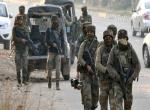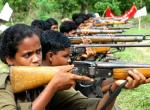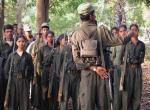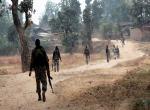On 11th March 2014, Naxalites ambushed a Road Opening Party of the Chhattisgarh Police and the Central Reserve Police in Bastar Division of Chhattisgarh killing fifteen policemen and an innocent civilian. This happened in the Jhiramghati area, very near Darbaghati where last year much of the senior leadership of the Chhattisgarh Congress was wiped out in an ambush, which killed twenty-six people, including members of the police escort. Earlier still, when the Collector of Sukma was abducted and held hostage, the Naxalites shot dead in cold blood the two personal security officers of the Collector, one a Muslim and the other a tribal. This region saw the deadliest ambush on the police ever, when 75 jawans were killed in one incident alone. Even at the height of the Nagaland insurgency, this magnitude of casualties in one incident had not been suffered by jawans of the Army or the Police. In the fight against Naxalism, more than 3000 policemen have been killed, about 1500 in Chhattisgarh alone.
The Naxalite dominated districts have the local population, largely tribal, living in remote areas, with poor infrastructure and with considerable poverty. In old Madhya Pradesh, the southern part of which has become Chhattisgarh, there was always the Ryotwari system of tenure, which meant that there were no intermediaries between government and the agriculturist, who was the Bhoomiswami or owner of the land. In 1951 even the intermediaries for revenue collection and management of common lands, the Malguzars, were abolished. In Bastar, later extended to the whole State, the Aboriginal Tribes (Protection of Interest in Trees) Act was in operation and this ensured that the tribes would be protected from exploitation on account of timber standing on their bhoomiswami land, with felling being permitted only under strict control and that, too, only by the Forest Department, with the permission of the Collector. There was also a total ban on transfer of tribal land to non-tribals. In other words, the exploitative Zamindari system which prevailed in neighbouring Telangana, formerly a part of Hyderabad State and then Andhra Pradesh, did not prevail in Madhya Pradesh which, before 1956, included Chandrapur and Gadhchiroli Districts of what is now Maharashtra. As a result of this, whilst Bastar and other tribal areas may have been poor, they were not in ferment caused by iniquitous land tenure. In trying to understand Naxalism, it is important to bear this fact in mind.
Long before Naxalbari, extreme left violence prevailed on a large scale in Hyderabad State in the Telangana portion because the peasants, largely tribal, were mercilessly exploited by the Zamindars. The resistance movement became so violent that in 1943 the Government of the Nizam of Hyderabad banned the Communist Party. When Hyderabad State was taken over by India after the Police Action, Telangana was marked out for special attention in order to restore the rule of law there. V. Nanjappa was appointed Special Commissioner and with great vigour he pursued the extremists and brought the area under control.
When the State of Andhra Pradesh was formed, it embarked on land reforms on the pattern of Madras Presidency and extended them to the Telangana Region. Various rural development programmes were also introduced. However, because the People’s War Group remained active, there was considerable violence. The Andhra Pradesh Police introduced three different tactics to deal with the situation. The first was to substantially increase the police presence in the disturbed region, establish fortified police stations which were impregnable to Naxalite attack and which provided a safe zone from which police counter measures could be launched. Once this exercise was completed, not a single police station in the region was successfully attacked by the extremist. This gave a boost to police morale.
The second measure was to set up a Special Task Force called the Greyhounds. This elite force had an integral intelligence wing, its officers and men were trained in jungle warfare and taught to be self-sufficient while operating in small units. By aggressive patrolling for area domination, by conducting strikes against Naxalite bases on receipt of credible intelligence, the Andhra Pradesh Police was able to restore command over the areas and bring the Naxalites under tremendous pressure.
The third measure was that the Andhra Pradesh Police identified the top leaders of the Naxalite movement, located them and then proceeded to eliminate them. Simultaneously the police also targeted the sympathisers of Naxalism who were playing an active role in giving them strength. Many of these persons were arrested and brought under judicial process. The net result of relentless policing by Andhra Pradesh was that many of the Naxalites fled the State and obtained sanctuary in neighbouring Odisha, southern Madhya Pradesh (now Chhattisgarh) and Maharashtra. In Madhya Pradesh and Maharashtra, Naxalism was not home grown, but the foreign elements who came in organised the tribals and because the reaction of the State was tardy and weak, this imported Naxalism soon took roots. The Naxalite leaders were ruthless. Anyone who opposed them locally was liquidated and soon a reign of terror was established whereby the question of resistance by local people was not allowed to rise. In Madhya Pradesh, two officers, L.K. Joshi of the IAS, Commissioner, Bastar Division, through his outreach to the people and A.N. Pathak of the Indian Police Service, through his own leadership, personal bravery and continuous presence in the field, were not only able to keep Naxalism in check but had brought the situation to a stage where Naxalites would soon have been pushed out. At this stage, Digvijaya Singh, then Chief Minister of Madhya Pradesh, under the misguided impression that the problem was socio-economic and should be dealt with accordingly, ordered the extra police out of Bastar, thus leaving a vacuum. The Naxalites flooded in to fill the vacuum, all the good work of the past was undone and now violent extremism had a firm base in southern Madhya Pradesh. In 2000, the new State of Chhattisgarh was carved out of old Madhya Pradesh. It was too small, too parochial, too bereft of administrative resources, for handling Naxalism, which the larger State of Madhya Pradesh could have done. Today, despite large scale injection of the Central Reserve Police, large swathes of southern Chhattisgarh are under the total control of the Naxalites. Once again, this fact of territorial loss must be borne in mind if we are to understand the true nature of the problem.
There is a group of activists, whose names are well known but which need not be repeated here, who argue that Naxalism is only a reaction to the traditional and age old exploitation of the tribal people, who are denied access to education, health and basic services, whose lands have been taken away from them and who are even under the threat of having their ethnicity destroyed. It is to protect the downtrodden that the Naxalites are there. Every organ of government is a part of the exploiters and, therefore, the Naxalites are justified in eliminating government functionaries by physical liquidation. Every successful action against the security forces is welcomed by these people, every attempt by the State to restore order is decried and an environment is created in which the Naxalites are heroes and State is the villain. A hero can do no wrong, a villain can do nothing right, or so say these activists.
There is a standard response to every incident, every ambush, in which policemen are killed. Ministers and government functionaries always say that this is a dastardly act of desperation of cowards. The activists laud every ambush as a victory of the people, a natural response of the tribals against exploitation. The fact is that the ambushes are not acts of desperation of cowards. They are deliberate, designed, well planned actions of motivated and highly organised groups of terrorists whose sole objective is to so demoralise the security forces so that the Indian State loses control over territory. One fact of which special notice must be taken is that every single attack by the Naxalites is aimed at killing every single policeman and then to booby trap the dead bodies of the policemen so that rescue parties may suffer injury or worse as they try to recover the bodies. No quarter is given to any policeman, no mercy is shown, so much so that even the basic fundamentals of the Geneva Convention are not followed. No prisoners are taken, no respect shown to the bodies of the slain and all that is aimed at is the disintegration of the police. Has anyone, the sympathisers of the Naxalites, the so called activists, the intellectual mentors of the extremists, ever said a condemnatory word about this extreme violence? However, even legitimate police measures to restore order are immediately condemned by the do-gooders as police brutality and unfortunately even our Courts and Human Rights Commissions fall prey to this temptation to attack the police. It is even more unfortunate that within the government itself, there are so many people, including P. Chidambaram, who refuse to see the true nature of the Naxalite terror and still harbour a feeling that the problem is socio-economic and not one of law and order. It was shocking to hear E. Rammohan Rao, former DGP, Border Security Force, stating on TV that the problem was not amenable to a police solution and that the question must be asked, “What led to the emergence of Naxalism?” At some stage this becomes relevant, but today we are faced with a situation in which law and order has broken down, the writ of government does not run, large chunks of territory are not under the control of government and ruthless murderers are calling the shots. The causes of Naxalism can be gone into later but today the government can have only one objective, which is to regain territory, reestablish the rule of law and restore law and order.
In order to restore governance to the Naxal affected areas, first and foremost the government must understand the nature of the Naxalite movement. The Naxalites do not want development; which is why they do not allow roads to be constructed, they blow up school buildings and do not allow schools to function, deployment of normal civil administration staff is not permitted, trade and commerce are hindered and money is collected through loot. Under these circumstances, the institutions of democracy and of decentralised local government cannot prosper or gain strength. If development and good governance are not the objective of the Naxalites, if the destruction of the security forces is considered the normal method of interaction with government then, by reductio ad absurdum, the only objective of the Naxalites can be the destruction of the Indian State. What is shocking is that even today government refuses to acknowledge that it is engaged in a war, a war which it cannot win unless it acknowledges the enemy to be an enemy and to deal with him as one would be in a war, that is, with no holds barred. The might of the Indian State has to be used to restore the presence of the Indian State in the Naxalite hit districts and let there be no pussyfooting around the problem The very government which established the National Investigating Agency using Entry 1, List 1 of the Seventh Schedule by stating that anything which threatens the State must be treated as an attack on the State and falls within the general definition of Defence of India, cannot simultaneously use Entries 1 and 2 of List 2 of the Seventh Schedule to claim that law and order is a State subject and the Naxalite threat falls within this definition. Now is the time to stop pretending that everything is normal in the Naxalite areas and stating that a slightly higher police presence which, nevertheless, treats Naxalites as fragile objects to be handled with care, can succeed. War is cruel. War may cause collateral damage, but losing the war destroys the nation itself. Can we afford to lose the war?
Undoubtedly government has professionals to advise it on strategy and tactics. Much of the action takes place in afforested areas and here it might be worth recollecting the doctrine whereby Field Marshal Sir William Slim, after being crushingly defeated by the Japanese in Burma, went about the task of laying the foundations of victory and training the XIV Army for this purpose. The nature of warfare in Burma was somewhat similar to that in Bastar in that there are the Naxalites, who know the terrain and are buoyed up by a series of successful ambushes against the security forces who, in turn, are increasingly demoralised as they lose large numbers of men. In Burma, of course, the Japanese were the enemies and it is the British who were on the run and thoroughly demoralised. In his book “Defeat Into Victory”, Slim says, (i) “The individual soldier must learn, by living, moving and exercising in it, that the jungle is neither impenetrable nor unfriendly. When he has once learnt to move and live in it he can use it for concealment, covered movement and surprise. (ii) Patrolling is the master key to jungle fighting. All units, not only infantry battalions, must learn to patrol in the jungle, boldly, widely, cunningly and offensively. (viii) If the Japanese are allowed to hold the initiative they are formidable, when we have it they are confused and easy to kill. By mobility away from roads, by surprise and offensive action, we must regain and keep the initiative”. The police in the Naxal affected areas must operate by the same principles. These include terrain familiarisation, aggressive patrolling, deep penetration into Naxalite areas and bold strikes which inflicts heavy casualties. Unfortunately, today’s position is that the Police still moves in a conventional manner, thus making it vulnerable to successful ambush. In an ambush, the ambusher chooses his ground, generally occupies high ground and then lures the ambushed party into a killing ground which can be enfiladed with fire. In the Jhiramghati incident, a forty-five strong patrol first went to investigate a burning vehicle and then, bunched up as it were, the patrol was subjected to heavy fire. Obviously we have not trained our men to go to ground, to attempt to reach high ground behind the enemy and then to engage the Naxalites on an equal footing. When Narendra Prasad, IPS was commandant of the Thirteenth Battalion, MPSAF in Nagaland at the height of the Naga insurgency, his unit was never successfully ambushed because it followed all the classical steps necessary to ensure the safe movement of troops. The camps of the battalion were so located that they commanded a height and the outposts could intercept any lurking Naga attack. Movement of Road Opening Parties was not only along roads and instead patrols went up on the high ground flanking the road and, by occupying it, were able to prevent Naga ambushers from attacking the road. We need to train the Chhattisgarh Police and the Central Reserve Police in these tactics so that ambushes can be taken on successfully.
Even today the police is armed with light weapons. When the enemy fires from high ground he must be dislodged by bringing heavy ordnance to bear on him. This means projectiles with explosive warheads fired from rocket launchers, armoured fighting vehicles with quick firing cannon of 20 mm or 30 mm calibre and helicopter gunships which deluge the high ground with fire from automatic weapons. Every successful ambush bring hordes of recruits to the Naxalites, every ambush that is broken raises the morale of the security forces. Why is there hesitation on the part of government to train and arm the police appropriately so that it can fight the new war?
Once the Naxalites are on the run, normal civil administration must be quickly established and development programmes accelerated, but in a way in which the local tribal can be both participants and beneficiaries. Till then let the police go on the offensive and, by successful ambush, by aggressive patrolling, by deep penetration into Naxalite areas by parties which are trained and equipped to overwhelm even larger groups of Naxalites and inflict heavy casualties, the Indian State has to carry the war successfully to the door step of the Naxalites. The activists, the media, even the human rights organisations and authorities have to be told very categorically that nothing will deter government from the main objective of destroying the Naxalites . Let this message also go to the Naxalites so that the sensible among them surrender themselves and the fanatics can be isolated and liquidated.
Dinesh Trivedi, DG, CRPF, has angrily stated that he will not leave the massacre of his men go unavenged. How? By brave words? The slog will be hard, but if Slim could rebuild the XIVth Army, then let the Chhattisgarh Police and CRPF rebuild themselves. If even one unit of the two Forces can spontaneously and successfully attack a Naxalite stronghold and virtually wipe out an entire dalam, that would be a start. Are you game, Dinesh Trivedi?
Published Date: 11th April 2014, Image source: http://i1.ytimg.com









Post new comment